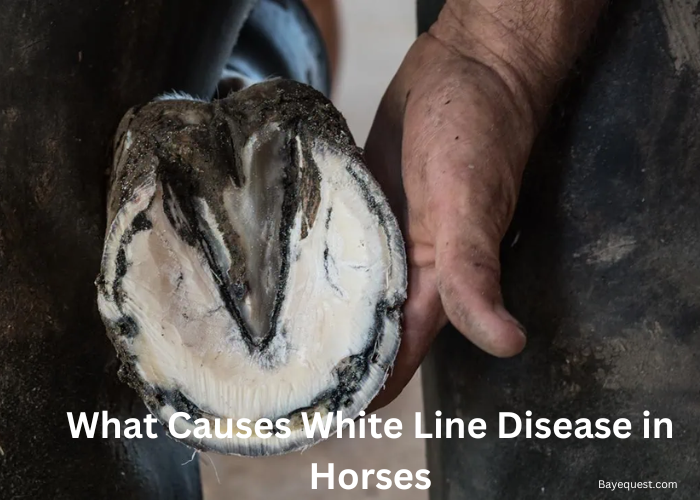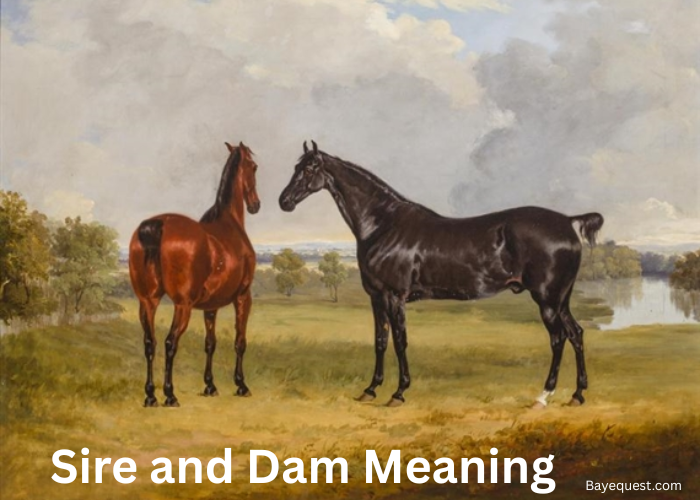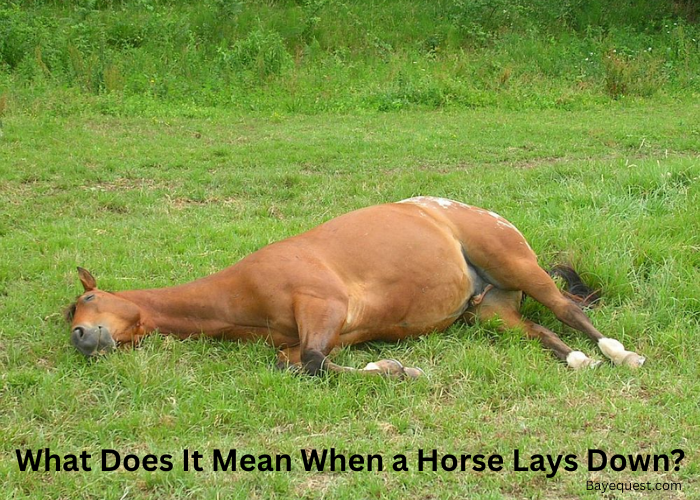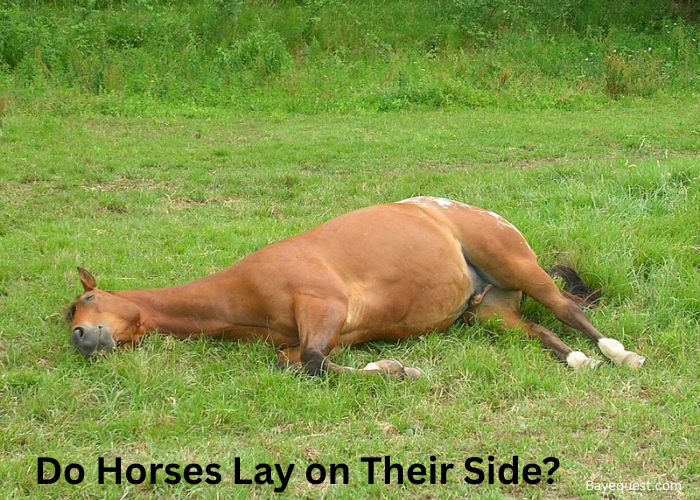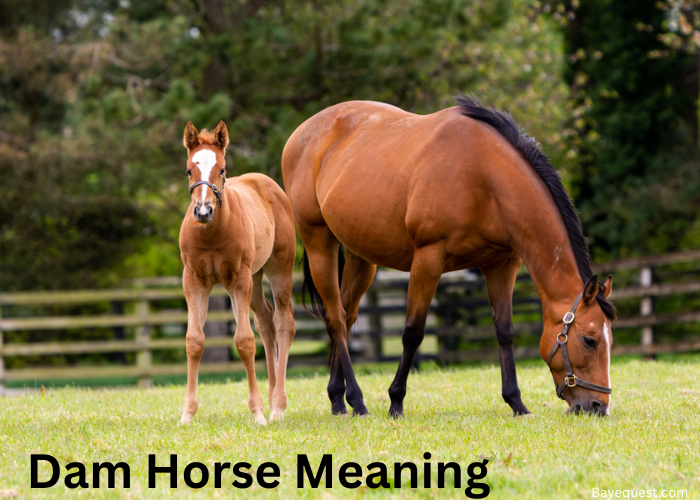White Line Disease doesn’t announce itself. One day, your horse looks fine, and the next, their hooves are in trouble.
It starts small, almost invisible. But if ignored, it can severely damage even the strongest horse.
This condition invades the hoof wall, breaking it down from the inside.
Wet environments, poor hoof care, and unnoticed injuries can all trigger this problem. But what exactly causes this hidden hoof menace?
Let’s explore the causes, uncover the risks, and learn how to protect your horse from White Line Disease.
What Causes White Line Disease in Horses? Key Takeaway
White Line Disease in horses happens when bacteria and fungi invade the hoof wall. Wet conditions, poor hygiene, and lack of proper hoof care are common causes. Weak hoof structure, trauma, and nutritional deficiencies increase the risk. Poor hoof wall conformation adds stress, making the hoof more prone to infection.
What is White Line Disease in Horses?
White Line Disease is a hoof problem that attacks the horse’s hoof wall. It starts where the hoof meets the sole, right at the white line.
Bacteria, fungi, or both sneak in, causing the hoof wall to break apart from the inside. It eats away at the hoof, making it weak and crumbly.
If left untreated, it can spread and make your horse lame. You might notice cracks, a hollow sound when you tap the hoof or even see a powdery substance.
It’s a silent invader that can cause big trouble if not caught early.
Anatomy of the Horse Hoof
The horse hoof is a complex structure that acts like a tough, protective shoe and a shock absorber all in one.
It has several key parts, each playing a role in the horse’s overall movement, balance and protection. the parts include:
Hoof wall. This is the hard, outer part of the hoof that you see. It protects the inside structures and bears most of the horse’s weight. Think of it like the tough outer shell.
Sole. The bottom of the hoof, slightly concave, which helps with grip and protects the inner structures. It should not bear much weight.
Frog. The V-shaped, rubbery part in the middle of the hoof. It acts like a cushion, providing grip and helping with circulation when the horse moves.
White line. This is the thin, light-colored strip where the hoof wall meets the sole. It’s crucial because it binds the outer hoof wall to the rest of the hoof. This is the area that White Line Disease attacks.
Bars. These are extensions of the hoof wall that run alongside the frog, adding strength and structure to the hoof.
Digital cushion and internal structures. Inside the hoof, there’s a digital cushion and other soft tissues that absorb shock. The hoof also contains bones like the coffin bone and sensitive laminae, which support and attach the hoof to the leg. (Read also: Horse Leg Anatomy.)
Signs of White Line Disease
Signs and symptoms of White Line Disease can sneak up on you, but here’s what to watch for:
1. Crumbly, powdery hoof wall. The hoof wall may look weak, flaky, or have a chalky texture, especially near the white line.
2. Separation of the hoof wall. You might notice a gap or hollow space where the hoof wall pulls away from the sole. This separation is a key sign.
3. Visible cracks or holes. Cracks or small holes in the hoof wall, often packed with debris, are common indicators.
4. Foul odor. A bad smell from the hoof can suggest infection, as bacteria and fungi are at work.
5. Lameness or sensitivity. The horse may show signs of discomfort, favor a leg, or become lame if the disease progresses.
6. Hollow sound when tapped. The affected area may sound hollow or empty when lightly tapped with a hoof pick.
What Causes White Line Disease in Horses?
White Line Disease doesn’t just happen overnight. It’s often triggered by a mix of factors that weaken the hoof.
Let’s get into some of the main causes:
Laminitis
Laminitis is a painful condition that affects the sensitive tissues inside the hoof. When a horse has laminitis, the hoof wall weakens and starts to separate.
This opens the door for bacteria and fungi to sneak in and cause White Line Disease. The hoof wall and the sole lose their bond, creating the perfect hiding spot for infection.
Horses with chronic laminitis are especially at risk because their hooves are already compromised.
Keeping laminitis in check through proper diet, management, and care is crucial.
It’s a double whammy—laminitis damages the hoof, and White Line Disease comes in to make things worse.
Regular vet checks and hoof care are your first line of defense.
Poor hoof hygiene and environment
A dirty, damp environment is bad news for hooves. Muddy paddocks, wet bedding, and poor stall conditions create a breeding ground for bacteria and fungi.
When a horse’s hooves are constantly exposed to these conditions, the hoof wall weakens. The white line starts to break down, making it easy for infections to take hold.
Regular cleaning of hooves, keeping the stall dry, and providing clean turnout areas can make a huge difference.
Even simple steps, like picking hooves daily and checking for debris, help maintain a healthy environment.
A clean, dry hoof is much less likely to fall victim to White Line Disease.
Trauma and mechanical stress
Hard impacts, over-trimming, or even an ill-fitting shoe can cause trauma to the hoof. These small injuries may seem harmless at first but can weaken the hoof wall over time.
When the hoof is stressed or damaged, it becomes vulnerable to White Line Disease. Tiny cracks or gaps start to form, allowing bacteria and fungi to enter.
Even things like excessive riding on rocky terrain or improper hoof balance can put extra strain on the hoof.
To reduce the risk, make sure your horse is properly shod and trimmed by a knowledgeable farrier.
Protecting the hoof from unnecessary trauma is key to keeping it strong and healthy.
Nutritional deficiencies
A healthy hoof starts from within, and nutrition plays a big role. Lack of key nutrients like biotin, zinc, and essential amino acids weakens the hoof wall.
This makes it more prone to cracks and separation, setting the stage for White Line Disease. A balanced diet that supports hoof growth is essential.
Supplements can help, but they’re not a magic fix—good nutrition needs to be consistent. It’s important to work with a vet or nutritionist to ensure your horse is getting what they need.
Poor diet equals poor hooves, and that’s an open invitation for White Line Disease.
Weak hoof wall structure
Some horses naturally have weaker hooves. This could be due to genetics, age, or past hoof problems.
A hoof wall that’s thin or brittle is much more likely to develop cracks or separations. These weak spots are prime targets for White Line Disease.
It’s not always something you can fix completely, but you can manage it. Regular hoof care, proper trimming, and possibly hoof supplements can strengthen the hoof wall.
It’s about giving the hoof every chance to stay healthy. If your horse has naturally weak hooves, they’ll need extra attention to keep White Line Disease at bay.
Inadequate hoof care and maintenance
Skipping regular trims or ignoring small hoof problems can quickly lead to bigger issues. When hooves aren’t properly cared for, cracks, chips, and separations can develop.
These gaps are like an open door for White Line Disease. A good farrier schedule and consistent hoof maintenance are crucial.
Even something as simple as picking out the hooves daily helps. It’s about catching the little things before they turn into big problems.
Good hoof care is the first line of defense against White Line Disease. Regular check-ups, proper trimming, and keeping the hooves clean can make all the difference.
Use of harmful hoof dressings
Not all hoof dressings are created equal. Some products that promise shiny, healthy hooves can actually do more harm than good.
Oils, harsh chemicals, and sealants can weaken the hoof wall, making it more prone to cracks and infections.
They may seal in moisture or trap debris, creating the perfect environment for White Line Disease to thrive.
Always choose hoof care products that are recommended by your farrier or vet. Less is often more when it comes to hoof dressings.
Keep it simple, and avoid anything that could compromise hoof health. A healthy hoof doesn’t need a lot of extras—just the right care and attention.
Here’s a table of hoof dressings that are likely to exacerbate white line disease:
| Hoof Dressing | How It’s Used | Why It Exacerbates White Line Disease |
| Petroleum-Based Hoof Oils | Applied directly to the hoof wall to enhance shine and moisture retention. Often used daily or before shows. | Traps moisture inside the hoof, softening the hoof wall and weakening its structure. This creates a damp environment ideal for bacteria and fungi. |
| Heavy Oils (e.g., Mineral Oil) | Brushed or sprayed onto the hoof to create a shiny, sealed appearance. Often used as a daily conditioner. | Creates a barrier that prevents the hoof from breathing and drying out, leading to a soft, weakened hoof wall that’s more prone to infection. |
| Sealants and Polishes | Used on the outer hoof to provide a glossy, finished look. Commonly applied before shows or competitions. | Blocks natural moisture exchange, making the hoof more susceptible to microbial invasion and further weakening the white line. |
| Animal Fat-Based Dressings (e.g., Lanolin, Lard) | Rubbed into the hoof to maintain moisture and prevent cracking. Often used frequently in dry conditions. | Can make the hoof overly soft and greasy, promoting a perfect environment for bacteria and fungi to thrive, worsening White Line Disease. |
| Tar-Based Products | Painted on the sole and frog for protection, commonly used in wet conditions. | While it provides a waterproof barrier, it also seals in moisture and debris, leading to a higher risk of infections inside the hoof. |
| Conditioners with Harsh Chemicals | Applied as a topical treatment to harden or shine the hoof. Often used without understanding their full impact on hoof health. | Harsh chemicals can strip the hoof of natural oils, weakening the hoof wall and making it more susceptible to cracks, separations, and infection. |
Risk Factors of White Line Disease in Horses
White Line Disease can affect any horse, but certain risk factors make some horses more susceptible than others. Here’s what can increase the chances:
Wet or unsanitary living conditions
Horses kept in muddy, wet, or dirty environments are at a higher risk. The constant exposure to moisture softens the hoof and creates a breeding ground for bacteria and fungi, setting the stage for White Line Disease.
Poor hoof conformation
Horses with flat feet, thin soles, or weak hoof walls are more vulnerable. Structural weaknesses in the hoof can lead to cracks or separations, giving infections an easy entry point.
Frequent changes in farrier care
Inconsistent trimming, poor shoeing practices, or frequent changes in farriers can stress the hoof. Improper care leads to mechanical imbalances, making the hoof prone to White Line Disease.
Chronic laminitis
Horses with a history of laminitis are at greater risk. The weakened connection between the hoof wall and the sole provides an opening for disease-causing agents.
Older age or health ompromises
Older horses or those with compromised immune systems may struggle to fight off infections. Conditions like Cushing’s disease can also make horses more susceptible.
High-performance demands
Horses that work on hard surfaces, jump, or perform intense activities often face mechanical stress on their hooves. This can lead to micro-damage, which paves the way for White Line Disease.
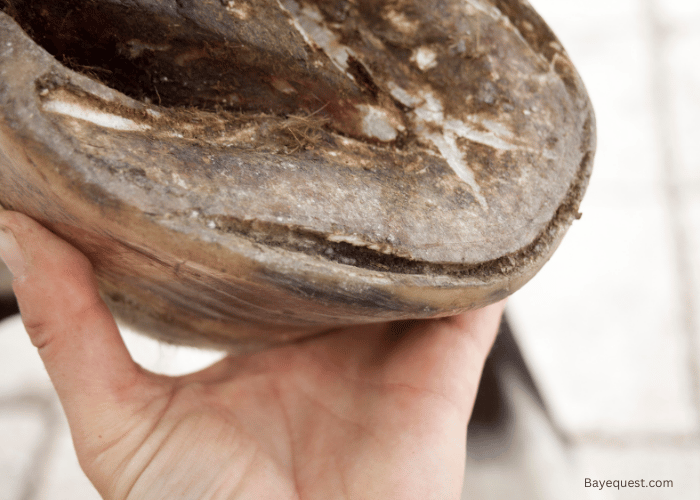
Diagnosis of White Line Disease
Diagnosing White Line Disease starts with a good look at the hoof. A farrier or vet will inspect the hoof wall, especially near the white line, for cracks, gaps, or separation.
They might tap the hoof with a hoof pick to listen for a hollow sound—this tells them there’s separation inside.
Sometimes, they’ll use hoof testers to check for pain or sensitivity.
In more serious cases, X-rays may be needed. X-rays show how far the disease has spread and how much of the hoof wall is affected.
This helps plan the treatment. It’s all about catching it early before it does too much damage.
Regular checks, even if you don’t see symptoms, can spot trouble before it turns into a big problem.
How to Treat White Line Disease in Horses
Treating White Line Disease starts with removing the infected, weakened hoof wall.
A farrier will carefully trim away the diseased areas, allowing air to reach the infection and stop it from spreading.
This might look drastic, but it’s crucial to get rid of the damaged hoof so healthy tissue can grow back.
Next, the exposed area needs to be cleaned. Antifungal and antibacterial treatments are applied directly to kill the remaining infection.
Your farrier or vet might suggest soaking the hoof in a special solution to help clear out any lingering bacteria or fungi.
Hoof protection is also important. The horse may need special shoes or pads to support the hoof while it heals.
Keeping the hoof clean and dry is key—change bedding often and avoid wet, dirty conditions.
Regular follow-up trims and checks are necessary to monitor progress and ensure the hoof is healing properly.
Early and consistent treatment is the best way to beat White Line Disease.
Medications Used in Treating White Line Disease
| Medication | How to Use | What They Do |
| Betadine Solution (Povidone-Iodine) | Soak the hoof in a diluted Betadine solution (mix with water) for 10-15 minutes, or apply directly to the affected area using a spray or brush. | Acts as an antiseptic, killing bacteria and fungi. It cleans the exposed hoof and helps prevent further infection. |
| White Lightning Gel | Apply directly to the affected area of the hoof, cover with a hoof boot or plastic wrap for about 30 minutes. Repeat as needed, usually 2-3 times a week. | A strong antimicrobial gel that kills bacteria, fungi, and spores, effectively treating the infection and promoting healing. |
| CleanTrax Hoof Soak | Mix the CleanTrax solution with water and soak the hoof for 30-45 minutes. Ensure the hoof is submerged completely. Use a hoof boot or large bag to contain the solution. | Penetrates deep into the hoof to eliminate bacteria, fungi, and spores without harming healthy tissue. Provides thorough disinfection. |
| Copper Sulfate Crystals | Mix with water to form a paste or use in powder form. Apply directly to the infected white line after trimming. Cover with gauze or wrap if necessary. | Kills bacteria and fungi, dries out the infected area, and helps to harden the hoof. Promotes a healthy environment for new hoof growth. |
| Thrush Buster | Apply a few drops directly to the affected area using the provided applicator. Repeat every few days as needed, depending on the severity of the infection. | Targets and kills bacteria and fungi. Helps to dry out the hoof, sealing off the damaged area and preventing reinfection. |
| Equine Hoof Disinfectant (e.g., Hooflex or similar) | Spray or brush onto the cleaned, trimmed area of the hoof. Allow it to dry completely before turning out the horse. Use daily or as recommended by the product instructions. | Provides a protective barrier while killing harmful microorganisms. Helps promote healthy hoof tissue regeneration. |
Prognosis of White Line Disease
The prognosis of White Line Disease depends on how early it’s caught and how aggressively it’s treated.
If detected early, with prompt and proper care, most horses can make a full recovery.
The hoof wall can regrow, and the hoof can return to full strength. Regular farrier visits, proper trimming, and keeping the hoof clean and dry are key to healing.
However, if White Line Disease goes unnoticed or untreated for too long, the prognosis becomes less favorable.
Severe cases can lead to significant hoof wall loss, structural damage, or even permanent lameness.
In these situations, it might take months of consistent care, special shoeing, and strict management to get the horse back on its feet—literally.
The key to a good prognosis is vigilance. Regular hoof checks, maintaining clean living conditions, and not ignoring small signs of trouble.
With the right care, even horses with severe cases can often return to their normal activities.
How to Prevent White Line Disease
Preventing White Line Disease is all about consistent care and proactive measures. Here’s how each method helps keep the hoof healthy:
Proper hoof care practices
Regular trimming and proper shoeing are at the heart of hoof health. A skilled farrier will keep the hoof balanced, remove excess growth, and ensure the white line stays tight and intact.
Picking out the hooves daily helps remove debris, manure, and mud that could harbor bacteria and fungi.
Clean hooves are healthy hooves, and staying on top of hoof maintenance minimizes the risk of White Line Disease sneaking in.
Farrier visits every 4-6 weeks are essential, even if your horse isn’t showing signs of problems.
Balanced nutrition
A strong hoof starts from the inside, and that means a balanced diet.
Hoof health depends on essential nutrients like biotin, zinc, copper, and amino acids, which support hoof wall strength and growth.
Without the right nutrition, the hoof can become weak and more prone to cracks and infections.
Make sure your horse’s diet includes these key nutrients, either through quality feed or supplements.
Good nutrition doesn’t just improve overall health. It’s a crucial line of defense against White Line Disease and other hoof problems.
Routine checks and maintenance
Routine checks allow you to spot problems before they become major issues.
Regularly inspecting your horse’s hooves can catch early signs of separation, cracks, or other abnormalities.
This way, you can address them promptly. Also, keep the horse’s environment clean and dry, reducing exposure to harmful microorganisms.
Maintenance isn’t about what happens when the farrier comes. It’s about daily attention, keeping hooves clean, and managing conditions that could lead to disease.
Appropriate exercise and management
Exercise is essential, but it needs to be managed correctly. Avoid overworking your horse on hard, rocky, or uneven surfaces that can stress the hoof and cause trauma.
Provide soft, clean ground for turnout to minimize the impact on the hooves.
Proper exercise helps promote healthy blood flow and hoof growth but should always be balanced with hoof protection and management.
Using boots on rough terrain or adjusting workout routines during wet conditions can help prevent unnecessary damage to the hoof wall.
Managing exercise wisely keeps the hooves strong and less vulnerable to White Line Disease.
Feeding Plans for Hoof Health
Feeding plans for hoof health focus on providing the right nutrients that support strong, resilient hooves. The key elements include:
Biotin
This B vitamin is essential for hoof growth and strength. Adding biotin supplements can improve hoof quality, especially for horses with weak or brittle hooves.
Zinc and Copper
These trace minerals play a crucial role in hoof development.
Zinc supports cell division in the hoof wall, while copper helps strengthen the connective tissue, reducing the risk of cracks and separations.
Amino Acids (Methionine and Lysine)
Amino acids are the building blocks of protein, vital for healthy hoof structure. They promote keratin production, which is critical for a strong hoof wall.
Omega-3 Fatty Acids
Found in flaxseed or fish oil, omega-3s help reduce inflammation and support overall hoof health by improving circulation and tissue repair.
A balanced diet with these nutrients and quality forage provides a solid foundation for healthy hooves.
Supplements for Hoof Growth
Here are the supplements commonly used for hoof growth, along with what they do and some common brands:
| Supplement | What it Does | Common Brands |
| Biotin | Supports keratin production, promoting strong and healthy hoof walls. | Farrier’s Formula, Biotin Plus, Hoof Rite |
| Methionine and Lysine | Essential amino acids for protein synthesis, crucial for hoof growth and strength. | Kentucky Equine Research (KER), SmartHoof Pellets |
| Zinc and Copper | Zinc aids in cellular repair and growth, while copper strengthens connective tissue. | Grand Hoof + MSM, Nu-Hoof Maximizer |
| MSM (Methylsulfonylmethane) | Supports collagen formation, reduces inflammation, and enhances hoof structure. | Corta-Flx, SmartHoof Ultra |
| Omega-3 Fatty Acids | Reduces inflammation, enhances circulation, and improves overall hoof quality. | Omega Horseshine, Equine Omega Complete |
| Calcium and Phosphorus | Provides essential minerals for bone and hoof integrity, supporting healthy growth. | Hoof Builder, Cal-Phos Supplements |
White Line Disease vs Thrush
White Line Disease and Thrush are both hoof problems, but they’re not the same.
White Line Disease targets the hoof wall, especially the area where the hoof wall meets the sole—the white line.
It happens when bacteria or fungi invade and start breaking down the hoof from the inside.
You’ll see separation, crumbling, or a hollow sound when tapped. It’s a silent attacker that weakens the hoof’s structure.
Thrush, on the other hand, goes for the soft, spongy part of the hoof called the frog. It’s often caused by wet, dirty conditions and shows up as a black, smelly goo in the crevices of the frog.
Thrush is mostly about poor hygiene and thrives in moist, mucky environments.
So, White Line Disease is about the hoof wall breaking apart, while Thrush is a stinky infection of the frog.
Both need attention but attack different parts of the hoof in different ways.
White Line Disease in Horses: FAQs
Is white line disease painful?
Yes, White Line Disease can be painful, especially as it progresses. The disease breaks down the hoof wall, causing instability and pressure on sensitive tissues. As the hoof weakens, the horse may experience discomfort or lameness, particularly when the separation is severe.
What does WLD do?
WLD attacks the white line of the hoof, where the hoof wall meets the sole. It breaks down the hoof wall, causing separation, cracks, and instability. This opens the door for bacteria and fungi, further damaging the hoof and potentially leading to lameness if not treated promptly.
Can a horse recover from white line disease?
Yes, a horse can recover from White Line Disease with proper treatment and care. Early detection, trimming away the infected hoof, applying antifungal or antibacterial treatments, and maintaining a clean environment are key. With consistent management, most horses can regain hoof health and return to normal activity.
White Line Disease in Equines: Conclusion
White Line Disease is like a thief in the night, sneaking in through cracks and weak spots you didn’t see coming.
But here’s the thing: with the right care, a clean environment, and a watchful eye, you can keep it from taking hold.
Proper hoof care, a balanced diet, and regular checks are your best defense. Don’t wait until those tiny cracks turn into big problems.
Stay ahead of the game, keep those hooves in top shape, and you’ll outsmart White Line Disease every time.
Now, get to know what horse wolf teeth are to understand how these small, often hidden teeth can impact your horse’s comfort, biting, and overall performance.


